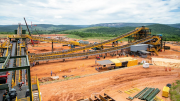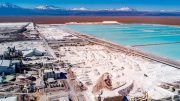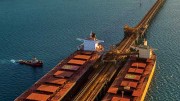Patricia Mohr, vice-president of economics and commodity market specialist at Scotiabank in Toronto, will release her metal price forecasts for 2015 in her annual year-end report at the end of December. But she agreed to share some of her thoughts on base metals, gold and uranium a little beforehand with The Northern Miner.
The Northern Miner: Some people seem to think 2015 will be a writeoff for mining and metals and don’t expect a recovery until mid-2016 or even 2017. What are your views?
Patricia Mohr: I’m a little bit more optimistic for the base metals. In fact, I think when you look at the average prices this year you’ll discover that prices late this year are actually higher for most of the base metals than they were late last year. The one exception to that is copper, which is a little lower than it was in late 2013.
If you look at zinc, it was trading at US$1 per lb. on Dec. 1, and the London Metal Exchange (LME) official cash settlement price at the end of 2013 was US89.03¢ per lb. Aluminum is averaging US95¢ per lb. this year, and in December 2013 it averaged US78.8¢. Nickel is averaging US$7.30 per lb. and was US$6.30 per lb. in December 2013.
Many of the base metals, with the exception of copper, have actually edged up this year — and it’s on fundamentals, and despite lacklustre global economic conditions.
I expect zinc will move higher next year, and nickel also. Aluminum will probably move higher as well, the only one that will drift lower, but not too much lower, is copper.
So I’m not that negative. I think the equity valuations now are oversold — very much oversold as a matter of fact — on fundamentals.
In the case of nickel and zinc, recovery has more to do with supply developments than it has with demand.
Century, which is the world’s third-largest zinc mine, is going to be closed in the third quarter of 2015 because of mine depletion, and in 2016 Lisheen will close, and this comes after closures of the Brunswick and Perseverance mines, and a number of other smaller mines in Canada, so I think zinc supply is going to be quite tight next year.
It might be a bit ambitious, but I’ve been forecasting US$1.25 per lb. for zinc next year. Maybe it won’t get that high, but this year the price is going to average US98¢ per lb. — so almost US$1 per lb.
It’s tricky to make a nickel forecast because it has had a rally this year and it’s been quite volatile.
It has moved up this year, and that is because of the ban implemented in Indonesia in January 2014, banning all exports of unprocessed nickel ore.
China nickel pig iron producers increased imports of nickel containing ore from the Philippines as an offset, but it’s lower quality, and I’m not sure how much they can import from the Philippines, so there’s a good chance that China’s stockpile of ore on hand in mid-2015 is going to look lower, and this of course is nickel pig iron, which is used in making stainless steel.
I think prices by mid-2015 are going to have another upward lift, and for next year it’s quite possible it will average over US$9 per lb.
This year the average is US$7.65 per lb. and in 2013 it was US$6.80 per lb.
It’s on an upward trajectory and I don’t think people should say otherwise. So while yes, people are quite negative, let’s not overdo it.
That goes for aluminum also. It appears that after many years of surplus around the world for aluminum ingots, the markets have moved into closer balance this year.
For a number of years what happened was that the supply and demand balance in the Western world outside of China was in a deficit, but aluminum prices on the LME have not moved up because China has put in place a brand-new aluminum smelter industry in the northwestern part of the country, based on low costs and quite ample reserves of steam coal for electricity.
However, while they expand smelter capacity, demand growth for aluminum around the world has been good, so aluminum is actually a growth market and the reason for that is things like the light-weighting of motor vehicles.
The average motor vehicle today in North America and in China is using more aluminum, because it’s a lighter metal than, for example, zinc or other metals.
So there is a lot of light-weighting in vehicles, not only in cars but also in heavy trucks — and aluminum has been essential.
I think this year, despite the fact that China is expanding its aluminum smelter capacity, the global demand growth will move higher.
And I think the market is close to balance and aluminum prices have rallied. So while yes, a few years ago we sold Alcan to Rio Tinto, aluminum is still a big industry in Canada (Quebec and B.C.) and in North America.
TNM: What do you see in store for precious metals?
PM: For precious metals, I’m not optimistic on the gold price because we think the U.S. dollar is going to rally and strengthen against a basket of currencies around the world, and that’s because quantitative easing has ended in the U.S. with the end of the asset-purchase program in October, and it’s now zero.
It used to be that the U.S. Federal Reserve was buying US$85 billion a month initially, but they have ended that. So there is no quantitative easing in the U.S., and by mid-2015, Federal Reserve Chair Janet Yellen will move to drain the federal funds rate, but more importantly she will very well drain excess reserves from the U.S. banking system.
This is a money-supply concept, not an interest-rate concept. It has to do with the money supply. Remember Milton Friedman?
I’m not that optimistic about gold but one positive thing that has happened — and I haven’t had a chance to look at it in detail yet — is that the Indian government, a week or two weeks ago, decided that it would end its import restrictions on gold bullion, or lessen its restrictions, and that is important for gold.
I think the gold price next year will average US$1,110 per oz., but I might be too conservative, and that’s because of our expectation that the U.S. dollar will strengthen further, and gold often moves in inverse relation to the U.S. dollar.
The gold price in 2014 has averaged $1,265 per oz. and it averaged US$1,410 per oz. in 2013.
Silver will trade in line with gold, and I haven’t got that price forecast. I think the price will remain relatively low for silver because gold will be impacted by the U.S. dollar.
TNM: Uranium seems to be making a bit of a comeback.
PM: Uranium is mounting a modest recovery, which is good to see, and I was delighted to see the base price for term contracts move up to US$49 per lb. in November so close to the US$50 per lb. mark, which we haven’t seen for some years now.
The spot price is still US$39.40 per lb., but the market has lifted because Japan is going to restart two reactors. Municipal government approval, as well as Japan’s Nuclear Regulation Authority, has been received so they will be restarting two reactors, and there will probably be a further slow recovery for reactor restarts in Japan.
In the meantime, there is strong grow
th in the construction of nuclear reactors in China and India, so I think we can look forward to a slow, moderate recovery in uranium. I have an average spot price of US$45 per lb. for uranium in 2015.






Is that the Lisheen Mine that is closing (not Lachine)?